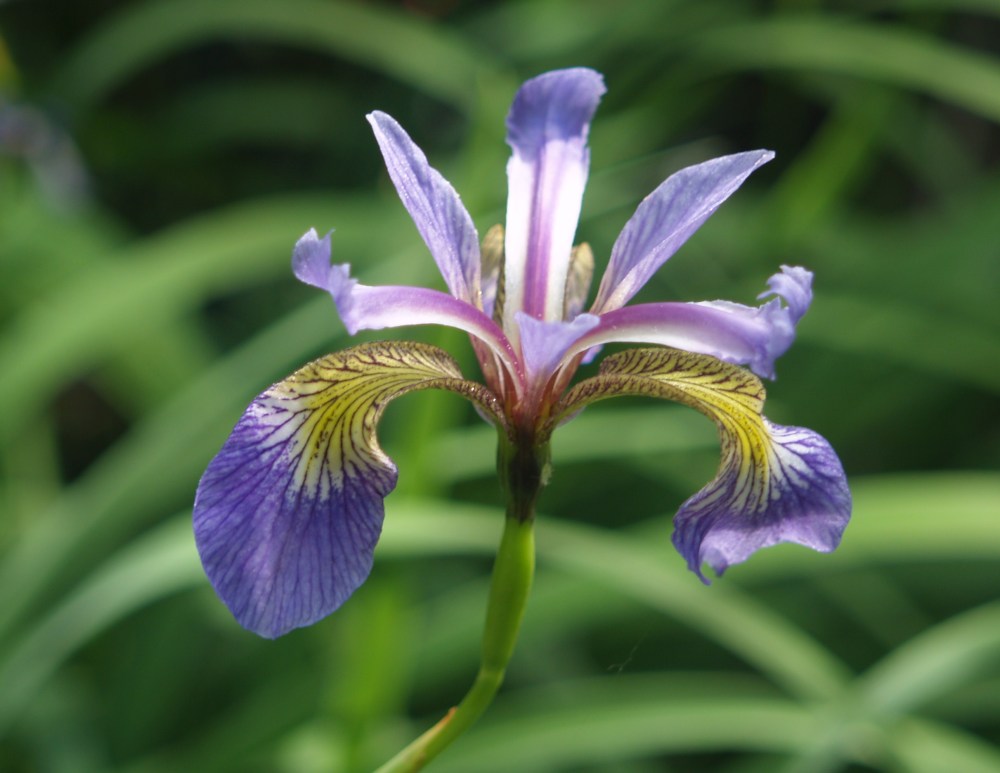 A year ago a clump of Japanese iris (Iris ensata, above) appeared from behind a low growing cypress in the garden that borders the large koi pond. Submerged in shallow water along the pond’s edge are a variety of Japanese and yellow flag irises (Iris pseudacorus, below), so it is not too surprising that a few seeds have escaped to nearby dry ground. Also, it is unsurprising that this seedling clump does not closely resemble any other Japanese iris in the garden. While yellow flags come true from seed (and these have spread through the pond), cultivars of Japanese iris do not.
A year ago a clump of Japanese iris (Iris ensata, above) appeared from behind a low growing cypress in the garden that borders the large koi pond. Submerged in shallow water along the pond’s edge are a variety of Japanese and yellow flag irises (Iris pseudacorus, below), so it is not too surprising that a few seeds have escaped to nearby dry ground. Also, it is unsurprising that this seedling clump does not closely resemble any other Japanese iris in the garden. While yellow flags come true from seed (and these have spread through the pond), cultivars of Japanese iris do not.
The flowers of this seedling clump are quite ordinary as irises go, though to my thinking none can be considered any less than extraordinary. The flowers are similar to the variegated Japanese iris, but the foliage is completely green rather than striped with white. Also, it is considerably taller than the lower growing variegated version, and in dry ground the iris is more vigorous than I would expect. Through hot and dry periods of last summer the foliage did not fade at all, and while I’ve had a few irises fail in either damp or dry conditions, this seedling clump appears quite content where it is. In all, despite its lack of pedigree, the iris is marvelous, though I have little doubt that it has no commercial appeal. 
In one of the garden’s smaller ponds blue flag iris (Iris versicolor, above) has spread moderately between partially submerged stones, but this spot is more heavily shaded than the koi pond, and I suppose that conditions are not ideal for it to spread further. In shade the flowers persist a bit longer than in full sun, but the blooms of any of the irises rarely last longer than a week or ten days.
By planting yellow and blue flags, and a handful of cultivars of Japanese iris, one iris or another will be flowering with hardly a break for nearly two months. For me, a pond filled with colorful koi, surrounded by lovely irises is as good as it gets.
(Note : Care must be taken to contain seeds from yellow flag iris, which can invade native wetlands if rainwater is allowed to flow through the area where they are planted. Japanese iris has not presented this problem, though I’ve heard that it can be aggressive under some circumstances.)
Beautiful. I’d love a pond like that, but I just don’t have the room, nor time to build one. But do you have a problem with mosquitoes with all that nice, calm water?
There are five ponds in the garden, and certainly plenty of mosquitoes, particularly the aggressive Tiger mosquitoes. But, I suspect few originate in the ponds. The koi take care of mosquito larvae in the large pond in the photo, and swiftly moving water discourages them in the smaller ponds. We have farm ponds on two sides of the property and just behind the garden is a swampy meadows of brambles and cattails. Also, scattered pots and paraphernalia through the garden hold bits of water, so there’s plenty of opportunity for breeding.
Beside the koi pond is probably the safest spot in the garden, since it is patrolled by dozens of dragonflies
Dave, how often, or if ever, do you divide your irises? i have read that left undivided they will produce less blooms, but my “thicket” of blue irises is still producing hundreds each spring. Other than crowding out other plants, i can’t see a reason to dig them up just yet.
love the blog. thanks!
Like you, I’ve never divided my Japanese irises and it doesn’t seem to have had any ill effect.